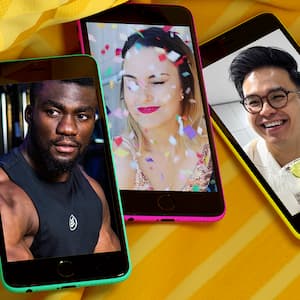‘What’s Brooke’s big bombshell?!’ was written beneath a GIF of Brooke looking solemnly at the camera. “I don’t want to lie to him” she mouthed.
Network Ten teased a game-changing secret reveal for episode nine of The Bachelor. When the moment finally came, after endless cliff-hanging ad breaks and close ups of an emotional Brooke Blurton, she revealed to Bachelor Nick Cummins the secret she’d been grappling with. She’d had two previous relationships with women in the past.
My three queer housemates and I let out a huge scream and threw our hands up in the air, spilling red wine everywhere. Nick then asked her if she preferred girls or boys. As someone who’s been asked that question upwards of one hundred times, I cracked my knuckles, gearing my tweeting fingers up for a night of being an angry bisexual on the internet.
We were furious. Painting Brooke’s sexuality as a huge secret or a ‘shameful past’ only serves to perpetuate biphobia. The need to reject or undermine her queerness painted the picture that bi/pansexual people have lower chances of having stable functioning relationships.
Rumours later flew about Brooke dating the other queer contestant, Jamie-Lee, who called them disappointing. “Like, if there's two bisexual people in a room, they must be together. I think that's such a backwards assumption,”
It proved the point that reality television can, and needs to do better dealing with queer love stories.
Dating shows like The Bachelor - now in its sixth season in Australia and twenty-second in USA - get ratings. They’ve been overwhelmingly heterosexual since their inception, because why wouldn’t they be? The premise of a finding ‘The One’ and having a fairytale romance has, on screen, been reserved for straight people. We haven’t been quite ready for queer love to look like that. Even before same-sex couples were legally able to get married, Channel 9’s Married at First Sight allowed straight people marry strangers purely for entertainment purposes.
Having queerness reflected in reality TV is paramount for the normalisation of non-heteronormative narratives. Behind the lavish flower arrangements, orchestral scores and expensive gowns, dating shows represent romance that society can embrace and understand.
While we twiddle our thumbs waiting for a lesbian Bachelorette, it’s been announced that Australian drag queen for E! Entertainment called The Bi Life.
The Bi Life represents a pivotal moment in the dating show genre by positively representing bisexual and pansexual narratives on screen.
“It’s high time there was a dating show for the large number of young people today, like me, who are attracted to more than one gender,” Courtney Act commented.
People attracted to more than one gender make up a massive part of the LGBTIQA+ community and the wider population, so having our romantic stories on screen is a huge deal.
Having Courtney Act, a queer genderfluid activist at the centre of this show is not insignificant. It signifies a shift in queer representation in reality dating shows - queer people actually making decisions about what it looks like.
The first handful of ‘gay’ dating shows throughout the early 2000s such as or all had a recurring motif: the protagonist had to try and figure out who was gay and who was straight among the suitors. Convincingly tricking the protagonist could get someone a huge sum of money, even if it meant pretending to be gay and duping a queer man to fall in love with him.
At the closure of the first season of A Shot At Love, Tila chose male contestants, revealing later that . In the second season, Tila chooses a girl who rejects her immediately before the finale ends. Bisexual relationships were on television, but serving little purpose other than to construct bi women as overly sexual and indecisive women who struggle to have functioning relationships.
The show was laden with biphobia, from the contestants who dramatically exit upon learning about Tila’s sexuality, to the framing of her relationships with the female contestants as purely pornographic with male contestants eagerly watching on.
At the closure of the first season of A Shot At Love, Tila chose male contestants, revealing later that she was pressured to by MTV. In the second season, Tila chooses a girl who rejects her immediately before the finale ends. Bisexual relationships were on television, but serving little purpose other than to construct bi women as overly sexual and indecisive women who struggle to have functioning relationships.
As society’s understanding of the queer community grows, it’s time for reality dating shows to reflect our stories. It’s time to see queerness treated not as an explosive secret, a dramatic deception or an opportunity to get vouyeristic ratings.
It’s time that queer people get access to the romantic storylines on reality TV dating shows. They might be cheesy, they might be constructed, but they’ll be there. They’ll be on our screens telling us that queerness isn’t controversial - that it has worth, value and normalcy.
I’ll go out on a limb and say it’s time for The Bi-chelor.
A dramatic gay rose ceremony extravaganza may sound over the top to some, but if straight people deserve it, so do we.
Dani Leever a headspace ambassador and online assistant at Archer Magazine. You can follow them on Twitter @DaniLeever.



